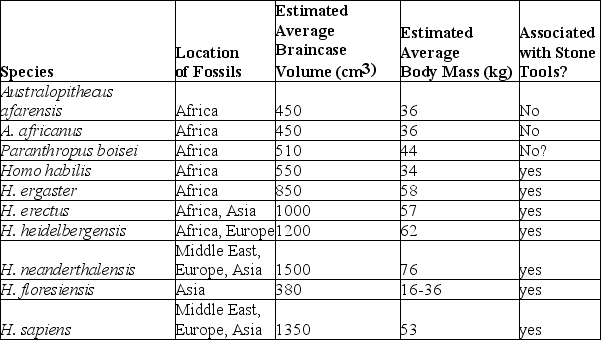Use the following information to answer the question.
Brown et al. and Morwood et al. reported in 2004 that they had found skeletal remains of a previously unknown type of hominin, now dubbed Homo floresiensis, on the Indonesian island of Flores. These hominins were small (approximately 1 meter tall) with small braincases (approximately 380 cubic centimeters) as compared with other hominins. The remains of H. floresiensis were found alongside handmade stone tools and the remains of dwarf elephants that also inhabited the island, suggesting that H. floresiensis was able both to make tools and to coordinate the hunting of animals much larger than itself. H. floresiensis is estimated to have lived at the site where the remains were found from at least 38,000 years ago to 18,000 years ago.
The table is a comparison of several characteristics of H. floresiensis to those of nine other hominin species (arranged roughly from oldest to most recent) . What do these data suggest?
Definitions:
Fuel
Substances that release energy when they undergo a chemical or nuclear reaction, commonly used for heating, powering engines, or generating electricity.
Prostaglandins
A group of bioactive lipid compounds having diverse hormone-like effects in animals.
Carbohydrates
Organic compounds made of carbon, hydrogen, and oxygen that serve as a major energy source for the body.
Polysaccharides
Large, complex carbohydrate molecules composed of many monosaccharide units joined together.
Q7: Many mammals have skins and mucous membranes
Q8: What are the primary sites of ethylene
Q24: Which of the following would increase the
Q40: Large proteins such as albumin remain in
Q49: Use the following information to answer the
Q55: Use the following information to answer the
Q67: Use the figure to answer the question.<br>A:
Q67: If all fungi in an environment that
Q75: In onions (Allium), cells of the sporophyte
Q76: Which of the following results would be